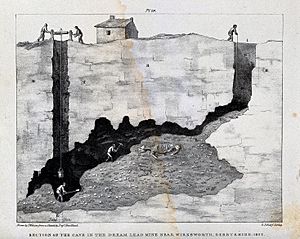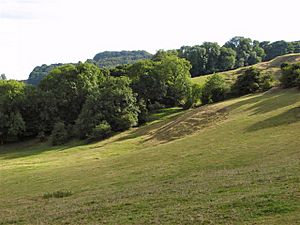Dream Cave facts for kids
Quick facts for kids Dream Cave |
|
|---|---|
| Dream Hole, Dream Mine | |
| Location | Derbyshire, England |
| OS grid | SK275530 |
| Depth | 15m |
| Elevation | 240m |
| Discovery | 1822 |
| Geology | Carboniferous limestone |
| Difficulty | 1 |
| Access | private |
| Features | Quaternary megafauna |
| Cave survey | 1823; 2016 (in COMPASS) |
Dream Cave (also known as Dream Hole or Dream Mine) is a natural cave made of limestone. You can find it near Wirksworth in Derbyshire, England.
Miners looking for lead discovered the cave in 1822. Inside, they found the almost complete skeleton of a woolly rhinoceros! They also found bones from other large animals. A famous geologist named William Buckland bought these bones. Today, you can see them at the Oxford Museum.
Contents
Where is Dream Cave?
Dream Cave is a natural hole in the ground. It formed in limestone rock. The cave entrance is on a grassy hill. This hill is west of Wirksworth town. It's also east of Carsington Water and looks over some woods.
The entrance is a deep, narrow crack in the limestone. The fields around it have many marks from old lead mining. Dream Cave is about 240 meters (787 feet) above sea level. It goes down about 15 meters (49 feet) deep. The cave tunnels run from west-north-west to east-south-east.
The cave was once completely filled with loose dirt and rocks. Most of this has been cleared out. So, it's hard to tell what the original layers of dirt looked like.
How Was Dream Cave Discovered?

Lead miners found Dream Cave in December 1822. They were digging a new shaft. This shaft was about 18 meters (60 feet) deep. They hoped to reach valuable lead ore in Dream Mine.
Instead, they broke into a large natural cave. This cave was completely filled with loose, clay-like earth and rock pieces. As the miners dug out this material, the loose fill started to move and collapse. When they removed enough material, they saw the cave's roof.
Near the middle of the collapsing dirt, the miners found many bones. They likely found a complete skeleton of a large animal. But the collapsing dirt caused the bones to separate. After clearing more, they realized it was the nearly complete skeleton of a woolly rhinoceros. Its scientific name is Coelodonta antiquitatis.
At first, no one knew how the cave connected to the surface. As the miners kept digging and removing dirt, a dip formed in the field above. Eventually, a connecting tunnel opened up. It was about 1.8 meters (6 feet) wide and 15 meters (50 feet) deep.
Amazing Animal Bones
In January 1823, a month after the discovery, William Buckland came to see the finds. He was a very important geologist from Oxford. By then, many bones had been moved by the landowner, Philip Gell.
Buckland wrote a detailed report about Dream Cave and its bones. He published it in his book, Reliquiæ Diluvianæ. He said the rhinoceros skeleton had a head, ten teeth, and half of its lower jaw. It also had many backbones, ribs, and leg bones. All the bones were well preserved. They belonged to a nearly full-grown animal.
No other rhinoceros bones were found. This means only one rhino likely died there. But bones from other large animals were also found. These included horse, ox, and deer. Mr. Gell later gave these bones to the Oxford Museum.
For a long time, people thought the rhinoceros bones from Dream Cave were lost. But in the late 1900s, scientists realized they were still at Oxford Museum! They were labeled as Rhinoceros tichorhinus, which is another name for the woolly rhinoceros.
New Discoveries About the Bones
Around the year 2000, scientists started studying the bones again. They also looked at a type of rock called flowstone that Buckland had collected. This flowstone was thought to have covered the bones.
Dating the flowstone showed it was about 36,450 years old. This suggests the woolly rhinoceros and other animals fell into Dream Cave over 37,000 years ago. This time period was during the last ice age.
In 2016, some of the original research team went back to Dream Cave. They also directly dated bones from aurochs (an ancient type of ox) and steppe bison. These bones were found with the woolly rhinoceros. The new dating showed they were between 45,083 and 48,613 years old.
The team believes Buckland was right. The complete woolly rhinoceros skeleton didn't just fall into the cave. Instead, it was washed in by a huge flood. Buckland thought this was from a "Biblical flood." But modern science thinks it was from a very strong flood. This kind of flood could happen when a lot of snow melted quickly after a cold winter. Such events were common during the ice age.
Animals Found in Dream Cave
The following animal bones from Dream Cave are now at Oxford Museum:
- Woolly rhinoceros (Coelodonta antiquitatis) – 74 bones
- Aurochs/steppe bison (Bos primigenius/Bison priscus) – not enough material to tell the exact species
- Reindeer (Rangifer tarandus)
- Horse (Equus sp.)
Only bones from large animals were kept. But it's likely that bones from smaller animals were also there. In 1823, Philip Gell wrote that the rhinoceros was in the middle of the cave. The ox and deer were at one end, and "smaller animals" were at the other end.
Why is Dream Cave Important?
The discovery of Dream Cave and its animal bones is very important for history. It happened just as William Buckland was working on his ideas about ancient caves and fossils. He was trying to understand how extinct animals ended up in caves, often linking it to the Biblical flood. Dream Cave was described in great detail in his 1823 book, Reliquiæ Diluvianæ.
Finding a nearly complete woolly rhinoceros in the UK is rare. What's even more special is that these bones show no signs of being eaten by hyaenas.
Threats to Dream Cave
In 2016, reports said that Dream Cave had been partly filled in. People had also dumped farm waste there. Dream Cave is not officially protected as a special scientific site. However, it was listed in 2013 as an "Important Metal and Gangue Mining Site in the Peak District." This means it's recognized for its historical mining importance.


